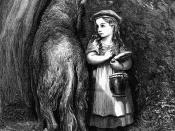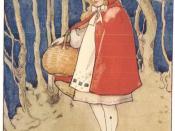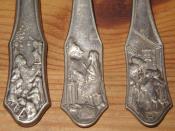The simplicity, linearity, and one-dimensionality of fairytales have led to a belief in their allegorical nature, a conviction that fairytales mean something quite different from what stands in the text. (Adapted from Bottigheimer. 1986: 6)
This essay will discuss symbolic elements of "Little Red Riding Hood" in terms of the tales by Charles Perrault and the Brothers Grimm.
In Perrault's version, the bourgeois society is being represented. Little Red Riding Hood is referred to as a "little village girl". This version of Little Red Riding Hood was written in the 17th Century, when Christian Patriarchal Absolutism was dominant, and the tale reflects the values of the era.
Grimm's version of the story also includes elements of Christian Patriarchal Absolutism, although it was written to express views of the Victorian era.
Perrault's tale is strongly influenced by the values of Christian Patriarchal Absolutism, which represented strict child-rearing methods. This is seen when Little Red Riding Hood disobeys her mother and talks to the stranger wolf.
The girl is expected to be able to control herself and not be coquette (flirtatious). Her punishment for improper behaviour is that she and her grandmother are 'devoured' by the wolf. This differs markedly from the Grimm tale, where the girl and her grandmother are 'eaten up', which is much less savage and more euphemistic.
In the 17th Century, manners were very important and natural behaviour was considered barbaric and uncivilised. There are strong sexual overtones within the Perrault tale, which are used to illustrate the girl's coquetry.
In the Victorian era the views of Christian Patriarchal Absolutism were magnified, with even more emphasis placed upon strict moral code, and sexuality was greatly repressed. All elements of sexuality are omitted from the Grimm tale and the moral changes from warning young girls about being...


